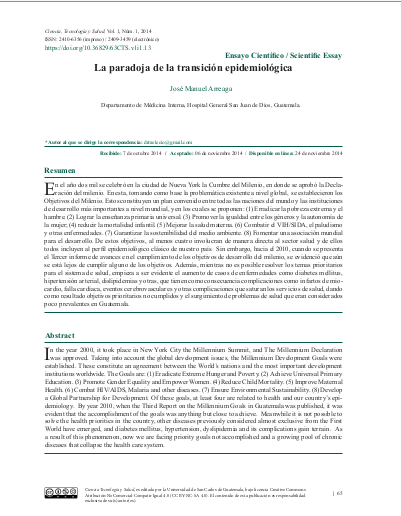The paradox of epidemiological transition
DOI:
https://doi.org/10.36829/63CTS.v1i1.13Abstract
In the year 2000, it took place in New York City the Millennium Summit, and The Millennium Declaration was approved. Taking into account the global development issues, the Millennium Development Goals were established. These constitute an agreement between the World’s nations and the most important development institutions worldwide. The Goals are: (1) Eradicate Extreme Hunger and Poverty. (2) Achieve Universal Primary Education. (3) Promote Gender Equality and Empower Women. (4) Reduce Child Mortality. (5) Improve Maternal Health. (6) Combat HIV/AIDS, Malaria, and other diseases. (7) Ensure Environmental Sustainability. (8) Develop a Global Partnership for Development. Of these goals, at least four are related to health and our country’s epidemiology. By year 2010, when the Third Report on the Millennium Goals in Guatemala was published, it was evident that the accomplishment of the goals was anything but close to achieve. Meanwhile it is not possible to solve the health priorities in the country, other diseases previously considered almost exclusive from the First World have emerged, and diabetes mellitus, hypertension, dyslipidemia, and its complications gain terrain. As a result of this phenomenon, now we are facing priority goals not accomplished and a growing pool of chronic
Downloads
References
Alwan, A., Armstrong, T., Bettcher, D., Branca, F., Chisholm, D., Ezzati, M. …Wild, C. (2011). Global status report on noncommunicable
diseases. Genova: Autor. Recuperado de www. who.int
American College of Physicians. (2012). MKSAP16 Cardiovascular Medicine. En P. Alguire (Ed.). Philadelphia, PA: Autor.
Guzmán, I., Gómez, D., Arana, P., Morataya, C., San- doval, M., Bran, B., y Leonardo, R. (2010). Pre- valencia de Factores de Riesgo Cardiovascular en la población de Guatemala. (Tesis de Licencia- tura). Universidad de San Carlos de Guatemala, Guatemala, Guatemala.
Ministerio de Salud Pública y Asistencia Social, Institu- to Nacional de Estadística, Universidad del Valle de Guatemala, Agencia de los Estados Unidos para el Desarrollo Internacional, Embajada de Suecia, Centros para el Control y Prevención de Enfermedades, Fondo de Naciones Unidas para la Infancia, Fondo de Población de las Naciones Unidas, O. P. de la S. (2010). Informe Final V Encuesta Nacional de Salud Materno Infantil 2008-2009. Guatemala: Autor.
Ministerio de Salud Pública y Asistencia Social. Go- bierno de Guatemala. (2014a). Morbilidad por VIH Por Departamento y Area de Salud. Guate- mala: Autor.
Ministerio de Salud Pública y Asistencia Social. Go- bierno de Guatemala. (2014b). Morbilidad por Malaria Por Departamento y Area de Salud. Guatemala: Autor.
Organización Panamericana de la Salud. (2012). Salud en las Americas. Panorama regional y perfiles de país. Washington, US: Autor. Recuperado de www.paho.org/saludenlasamericas/index. php?option=com_content&view=article&id=9 &Itemid=14&lang=es
Secretaría de Planificación y Programación de la Pre- sidencia. (2010). Tercer informe de avances en el cumplimiento de los objetivos de desarrollo del milenio. Guatemala: Autor.
Secretaría de Seguridad Alimentaria y Nutricional. Gobierno de Guatemala. (2014). Plan de acción contra el hambre estacional en el marco del plan del pacto hambre cero. Guatemala: Autor.
Shannon, R. (2012). Diabetes and cardiovascular disease: the ties that bind. European Heart Journal Supplements, 14(suppl B), B1-B3. https://doi.org/10.1093/eurheartj/sus004

Published
How to Cite
Issue
Section
License
Copyright (c) 2014 José Manuel Arriaga López

This work is licensed under a Creative Commons Attribution-NonCommercial-ShareAlike 4.0 International License.
El autor que publique en esta revista acepta las siguientes condiciones:
- El autor otorga a la Dirección General de Investigación el derecho de editar, reproducir, publicar y difundir el manuscrito en forma impresa o electrónica en la revista Ciencia, Tecnología y Salud.
- La Direción General de Investigación otorgará a la obra una licencia Creative Commons Atribución-NoComercial-CompartirIgual 4.0 Internacional









